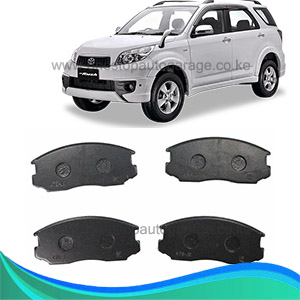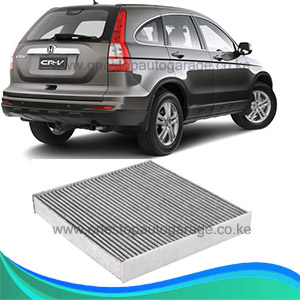-18%
Get Toyota Rush Fan Belt 6PK1590 in Kenya
The fan belt, also known as a serpentine belt, drive belt, or auxiliary belt, is a crucial component in a vehicle’s engine. It is responsible for transferring rotational power from the engine’s crankshaft pulley to various accessories such as the alternator, power steering pump, air conditioning compressor, and water pump. The 6PK1590 fan belt is a six-ribbed, 1590mm-long belt, designed for high durability and efficiency in driving multiple components simultaneously.
In this guide, we will cover the functions, benefits, types, common failure symptoms, and maintenance of the 6PK1590 fan belt, ensuring you understand its importance in vehicle operation.
What is a Fan Belt?
A fan belt is a reinforced rubber belt that connects the engine’s crankshaft pulley to various accessory pulleys, allowing them to function properly. The 6PK1590 designation means:
- 6PK – The belt has six ribs for improved grip and efficiency.
- 1590 – The belt is 1590mm in length.
The fan belt plays a vital role in keeping essential engine components operational, ensuring smooth vehicle performance.
Functions of the 6PK1590 Fan Belt
1. Drives the Alternator
The fan belt transfers power to the alternator, which is responsible for charging the battery and supplying electrical power to various vehicle components. A malfunctioning belt can lead to battery drainage and electrical failures.
2. Powers the Power Steering Pump
Many vehicles rely on the fan belt to drive the power steering pump, which assists in making steering easier and more responsive. A worn-out belt may cause heavy steering, making it difficult to maneuver the vehicle.
3. Operates the Air Conditioning Compressor
The A/C compressor depends on the fan belt to function. If the belt slips or breaks, the air conditioning system will stop working, leading to discomfort in hot weather.
4. Drives the Water Pump (in some vehicles)
In certain engine configurations, the fan belt powers the water pump, which circulates coolant to prevent the engine from overheating. A failing belt may lead to engine overheating and potential damage.
5. Reduces Engine Load and Enhances Efficiency
A properly functioning fan belt ensures that all accessories receive adequate power without straining the engine, leading to optimal fuel efficiency and performance.
Benefits of Using a High-Quality Fan Belt (6PK1590)
✅ Durability & Longevity – Designed with high-strength rubber and reinforcement materials, offering long service life.
✅ High Power Transmission Efficiency – Ensures smooth and efficient power transfer to engine accessories.
✅ Minimal Noise & Vibration – Reduces engine noise and vibrations for a quieter ride.
✅ Prevents Overheating & Electrical Failures – Ensures the alternator and water pump function properly.
✅ Improves Driving Comfort – Keeps power steering and air conditioning systems operational.
Types of Fan Belts
1. V-Belts
Older vehicles typically use V-belts, which drive individual components using separate belts.
2. Serpentine Belts (Modern Vehicles)
The 6PK1590 belongs to this category. A single belt powers multiple accessories, improving efficiency and reducing maintenance needs.
3. Timing Belts (Not the Same as a Fan Belt)
While similar in appearance, the timing belt synchronizes the camshaft and crankshaft and does not drive accessories.
Signs of a Failing Fan Belt
1. Squealing or Chirping Noises
A worn-out or loose belt may produce squealing noises, indicating slippage or misalignment.
2. Cracks, Fraying, or Wear on the Belt
Inspect the belt for visible cracks, cuts, or frayed edges, which indicate it needs replacement.
3. Battery Warning Light on Dashboard
If the alternator is not receiving power due to a failing belt, the battery will not charge properly, triggering the warning light.
4. Overheating Engine
If the fan belt drives the water pump, a failure can cause cooling system malfunction, leading to engine overheating.
5. Heavy Steering
If the belt drives the power steering pump, failure can result in stiff steering, making it difficult to turn the vehicle.
6. Non-Functional Air Conditioning
A broken or slipping belt can cause the A/C compressor to stop working, leading to loss of cooling.
Causes of Fan Belt Failure
🚗 Aging & Wear – Over time, the rubber material degrades, leading to cracks and loss of flexibility.
🚗 Improper Tension – A belt that is too loose or too tight can cause excessive wear, noise, or breakage.
🚗 Oil or Coolant Contamination – Fluids leaking onto the belt can weaken it and cause it to slip.
🚗 Misalignment of Pulleys – If the pulleys are not aligned properly, the belt may wear unevenly.
🚗 High Temperatures – Excessive heat exposure can dry out and weaken the rubber, reducing its lifespan.
Maintenance and Replacement Tips
1. Regular Inspection
Check the belt every 10,000–15,000 km for cracks, wear, or looseness. If it appears damaged, replace it immediately.
2. Check Belt Tension
A loose belt can cause slippage, while an over-tightened belt can strain components. Adjust the tension according to the manufacturer’s specifications.
3. Keep Pulleys Clean
Ensure that dirt, oil, or coolant does not accumulate on pulleys, as contamination can cause premature belt failure.
4. Replace Before It Fails
The typical lifespan of a fan belt is 50,000–100,000 km, depending on driving conditions. Don’t wait for a complete failure before replacing it.
5. Use High-Quality Replacement Parts
Always opt for OEM (Original Equipment Manufacturer) or premium aftermarket belts, like the 6PK1590, to ensure durability and compatibility.
6. Check Related Components
When replacing the belt, inspect the tensioner, idler pulleys, and accessory pulleys for wear or misalignment to prevent premature belt failure.
7. Avoid Excessive Load on the Belt
Overloading electrical accessories (e.g., adding high-power sound systems) can strain the alternator and fan belt. Ensure your electrical system is within capacity.
How to Replace a Fan Belt (Basic Guide)
- Turn Off the Engine & Disconnect the Battery – Ensure safety before starting.
- Locate the Belt Routing Diagram – Found in the engine bay or vehicle manual.
- Loosen the Tensioner – Use a wrench to relieve tension on the belt.
- Remove the Old Belt – Carefully slide it off the pulleys.
- Install the New Belt – Follow the correct routing pattern.
- Adjust the Tension – Ensure the belt is properly tensioned to avoid slippage.
- Start the Engine & Inspect – Listen for noises and check for proper operation.
Conclusion
The 6PK1590 fan belt is an essential component for powering key engine accessories, including the alternator, power steering pump, A/C compressor, and water pump. Regular inspection and timely replacement ensure smooth vehicle operation, improved efficiency, and safety.
Follow us on Facebook for more parts.




Reviews
Clear filtersThere are no reviews yet.